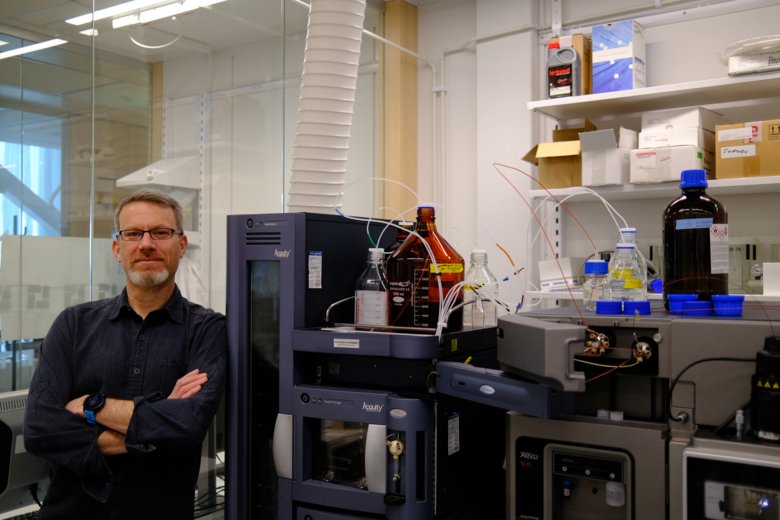Q&A: Metabolomics - the Stethoscope for the Twenty-First Century

Measuring the full complement of small molecules (the metabolome) can provide important insight into the health status of an individual. The measurement of metabolites is also the main theme of the recently established KI core facility for small molecule mass spectrometry (KI-SMMS). We talk with Craig Wheelock, Head of the newly founded Unit of Integrative Metabolomics in the Institute of Environmental Medicine (IMM), about the role of metabolomics in personalized health care.
What is metabolomics?
The omics technologies have proven incredibly insightful to biomedical research, from elucidating fundamental mechanistic biology to applications in precision medicine. Metabolomics is one of the newer omics methodologies and is in many ways still developing. Succinctly put, metabolomics is the study of the full complement of small molecules (metabolites) found in an individual (or any organism). The human metabolome is complex, with size estimates varying widely and reaching upwards of 1 million molecules compared to ~21,000 protein-encoding genes and 15,000 gene products, which are determined by 4 bases or 20 amino acids, respectively. This chemical diversity renders the metabolome analytically challenging to measure relative to other omics technologies.
How is metabolomic data used in the field of medicine today?
Metabolomics provides a real-time biochemical indicator of physiological status (metabotypes), reflecting the integration of genetic and environmental interactions, as well as treatment response, making it ideally suited for molecular characterization of an individual’s current – and future - health status. Many complex diseases, such as asthma, diabetes, rheumatoid arthritis, and psychiatric disorders are caused not by one but by multiple changes in the genome in combination with environmental exposures. Because of this, it is hard to understand how they collectively cause the disease. Genomic information alone is only one part of this process. The metabolome can provide increased molecular resolution to detect disease and importantly reflects the current ongoing physiological processes in an individual – including everything from your genome to your lunch. This makes it a very powerful technique for measuring an individual’s personalized health status and therefore an important component of personalized medicine approaches. Metabolomics has been called the stethoscope for the Twenty-First Century.
How are you applying these techniques in your lab?
Our work focuses on understanding the molecular underpinnings of obstructive lung disease, with a focus on asthma and COPD. According to the World Health Organization, an estimated 339 million people worldwide have asthma, which is among the most common chronic diseases of industrialized countries. Given the heterogeneity of asthma, we are using metabolomics to identify specific forms (phenotypes) of the disease. The concept is that the exact type of asthma an individual has will be reflected in their metabolome. Our primary application is in trying to identify individuals who will respond to treatment with novel immunotherapies. These antibody-based biologics can be very effective in treating severe asthma, but not all individuals respond to a given treatment. We are therefore attempting to use an individual’s metabotype to stratify them into responders and non-responders for treatment strategies, a so-called personalized medicine approach. This has the advantage of increasing the quality of patient care while simultaneously reducing health care costs. As part of these efforts, I have recently been appointed as a co-chair for complex diseases in Genome Medicine Sweden in an effort to bring the power of metabolomics into the Swedish health care system.
You’ve recently co-authored several papers on metabolomics and asthma. Briefly, give us the main highlights.
Yes indeed, the past year has been very productive for our group – but the papers really reflect several years of cumulative effort by many people in the laboratory. One of our major findings published in Nature Medicine examined the metabolomes of a cohort of >14,000 individuals and found that long-term use of inhaled corticosteroids, which is the standard of care for asthma control, results in adrenal suppression. These findings led to the actionable conclusion that individuals on higher doses of inhaled steroids should undergo routine screening for adrenal function. A related finding published in the European Respiratory Journal used metabolomics to discover that oral corticosteroid (OCS) treatment in asthmatics also resulted in extensive metabolic perturbations; however, carnitine metabolism was found to be systemically downregulated in severe asthmatics independent of OCS. These findings suggest that carnitine shifts reflect a metabolic deficiency of asthma that is not remedied with standard treatment (ICS or OCS), and the alteration in fundamental metabolism suggests that carnitine metabolism is a potential therapeutic target in asthma management. We also published a number of articles in the American Journal of Respiratory and Critical Care Medicine with collaborators that used metabolomics to identify multiple metabotypes of disease, suggesting that there are distinct individual treatable forms of asthma (endotypes) as well as that gene signatures of mast cell activation allow the detection of severe asthma phenotypes .These collective efforts led to an invitation to write a method article on the application of metabolomics in respiratory medicine for the European Respiratory Journal.
What’s the next step in your research?
A lack of stratifying diagnostics means that asthma treatments are often prescribed via a trial-and-error approach and there is substantial need to identify individual endotypes. We just received a 3M SEK grant from the Swedish Heart-Lung Foundation (Hjärt-Lungfonden) that we will use to continue our efforts to define the molecular underpinnings of asthma and then use metabolomics to identify groups of asthmatics who will respond best to treatment. We are working with several collaborators who have performed interventional studies with different biologic treatments. We are now using metabolomics to investigate whether we can predict an individual’s response to a given therapy. It is a function of getting the right treatment to the right patient at the right time.
We have recently founded the Karolinska Institute small molecule mass spectrometry core facility (KI-SMMS) located in the Institute of Environmental Medicine (IMM) with support from KI and Region Stockholm. Our vision is that this new facility will synergize research at KI by making the power of small molecule mass spectrometry and metabolomics readily available to the KI and Region Stockholm research community. These efforts are in collaboration with Waters Corporation, which is strategically located on the KI campus. The recent developments at KI and the Region Stockholm are very exciting and represent a great opportunity for synergize the technologies developed at for example SciLifeLab to make advances in personalized health care. Metabolomics will be an important contributor to this future.
While the research we perform is important, the communication of our findings to key stakeholders including patients and policy makers is vital to effect change. In this capacity, I am the current Director of Scientific Relations with the EU for the European Respiratory Society, where we work with members of the European parliament to enact legislation that is based on the best science to reduce and ultimately prevent the incidence of respiratory disease. It is arguably the most effective component of my research and certainly the most rewarding.
Recent publications
Metabolomics in pulmonary medicine - extracting the most from your data.
Reinke SN, Chaleckis R, Wheelock CE
Eur Respir J 2022 May;():
Metabolomic profiling reveals extensive adrenal suppression due to inhaled corticosteroid therapy in asthma.
Kachroo P, Stewart ID, Kelly RS, Stav M, Mendez K, Dahlin A, Soeteman DI, Chu SH, Huang M, Cote M, Knilhtilä HM, Lee-Sarwar K, McGeachie M, Wang A, Wu AC, Virkud Y, Zhang P, Wareham NJ, Karlson EW, Wheelock CE, Clish C, Weiss ST, Langenberg C, Lasky-Su JA
Nat Med 2022 04;28(4):814-822
Urinary metabotype of severe asthma evidences decreased carnitine metabolism independent of oral corticosteroid treatment in the U-BIOPRED study.
Reinke SN, Naz S, Chaleckis R, Gallart-Ayala H, Kolmert J, Kermani NZ, Tiotiu A, Broadhurst DI, Lundqvist A, Olsson H, Ström M, Wheelock ÅM, Gómez C, Ericsson M, Sousa AR, Riley JH, Bates S, Scholfield J, Loza M, Baribaud F, Bakke PS, Caruso M, Chanez P, Fowler SJ, Geiser T, Howarth P, Horváth I, Krug N, Montuschi P, Behndig A, Singer F, Musial J, Shaw DE, Dahlén B, Hu S, Lasky-Su J, Sterk PJ, Chung KF, Djukanovic R, Dahlén SE, Adcock IM, Wheelock CE
Eur Respir J 2021 Nov;():
Association of Differential Mast Cell Activation with Granulocytic Inflammation in Severe Asthma.
Tiotiu A, Badi Y, Kermani NZ, Sanak M, Kolmert J, Wheelock CE, Hansbro PM, Dahlén SE, Sterk PJ, Djukanovic R, Guo Y, Mumby S, Adcock IM, Chung KF,
Am J Respir Crit Care Med 2022 02;205(4):397-411
Metabo-Endotypes of Asthma Reveal Differences in Lung Function: Discovery and Validation in Two TOPMed Cohorts.
Kelly RS, Mendez KM, Huang M, Hobbs BD, Clish CB, Gerszten R, Cho MH, Wheelock CE, McGeachie MJ, Chu SH, Celedón JC, Weiss ST, Lasky-Su J
Am J Respir Crit Care Med 2022 02;205(3):288-299
Contact

